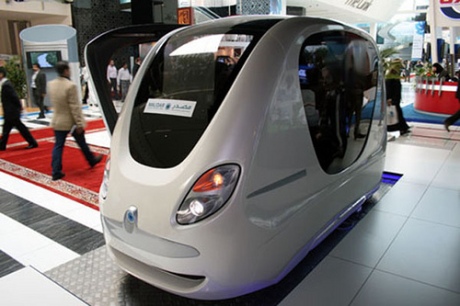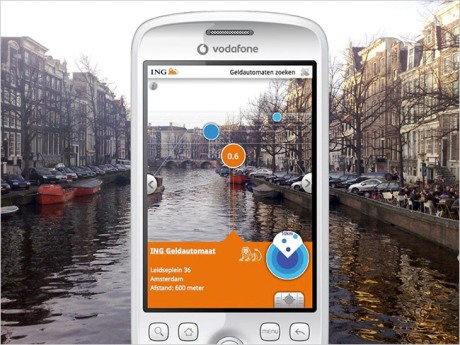Vehicles as networked objects?
July 29, 2009

Personal Rapid Transit (PRT) prototype for the planned city of Masdar
A link to Hammersmith’s latest thought piece exploring the opportunities of embedding logic and sensors into vehicles, as well as using social media to enhance the driving experience – from Trapster’s wiki geotagging of speed traps, to the potential to embed sensors in public parking spaces so that drivers can scan for open spaces, to combining DPW and police news feeds into GPS devices so that they provide useful, real-time route information:
http://thehammersmithgroup.com/images/reports/networked_vehicles.pdf
This piece focused more on personal vehicles rather than commercial ones – that would be a piece on its own.
Feel free to share thoughts, as always.
360i creates a beer keg that twitters
July 24, 2009
The good folks at the digital agency 360i came up with a clever hack to make a beer tap that twitters. The tap is connected to an electronic Keg-Meter, which determines flow, and sends tweets whenever a beer is drawn. Awesome proof of concept, and an idea that lends itself to considerable punning:
http://blog.360i.com/360i-news/introducing-tweetingbar
This is the sort of cleverness that we need to see more of – embedding logic, sensors, and transmitters into different objects to see how this transforms our relationship with them.
Augmented reality browser for mobile phones
July 15, 2009
Layar recently launched its augmented reality browser for mobile phones. It enables phones to use their camera to “see” a digital overlay of information over the physical world.
As you’re walking down a city street, it’s a way to graphically, intuitively connect with the data – e.g. point your phone at the Goldman Sachs building, and it could display the job openings there.
The New York Times did an interesting piece on it here.
Layar is a product of SPRX Mobile – definitely a company to watch.

Ten thoughts about the Internet of Things
June 26, 2009
Nine thoughts about the Internet of Things
1. The concept of ‘computers’ is moving away from the traditional model of desktops, laptops, and PDAs towards converged networks where processing power is embedded in all manner of objects and devices.
2. As a result of embedding computing power into these objects, we will move from keyboards and mice to a number of different input devices, including gestural controls (such as Wii wands and touch screens) and voice recognition. The conventional metaphor of the ‘desktop’ may need to shift to accommodate this.
3. Because many of these objects will have wireless sensors, they will be context-aware and can respond to changes in their environment. The possibilities for this have not yet begun to be explored in a significant way.
4. There will increasingly be a digital overlay of information for the physical world. First,
associating an IP address with these objects enables thing-to-person (T2P) and thing-to-thing (T2T) communications. This has been referred to as ‘the Internet of things.’ Second, innovations such as QR codes on posters, billboards, and television enable us to create direct ‘hotlinks’ from the real world to the Internet. Third, mobile phones or PDAs equipped with GPS enables locative media. The possibilities for this, too, have not yet begun to be explored in a significant way.
5. Digital widgets may replace some physical devices. As has become common with Web 2.0, independent developers will create apps for this platform, enabling functionalities that were never conceived of by the original creators. Adding features to your networked home or smart object may be as simple as downloading upgraded software to your iPhone.
6. These technologies will be as transformative as the Internet for a number of industries. In particular, the industries which have resisted change and innovation will be the ones most profoundly affected. It will be very difficult to ignore these innovations and still remain competitive.
7. There is significant market potential for these innovations. Many of these concepts will
follow the conventional diffusion of innovation, and will likely begin in industrial sectors
before filtering out to more commercial and entertainment applications. The adoption of
these technologies will be driven in part by market forces (technologies that entertain or
which enhance the quality of life) and in part by policy change (especially for technologies
regarding green buildings, energy efficiency, and alternate energies).
8. Networked objects create and record significant amounts of real-time data. Having this granular level of data allows us to create much more sophisticated analytics around how objects and devices are actually used.
9. Industry groups, corporations, and individual products will need significant advertising
and public relations support for their launch and ongoing marketing efforts.
10. Marketing firms which establish an early understanding of and dominance in these sectors will have an competitive advantage. These firms will not only understand how these
technologies can be used as platforms for new marketing strategies, but can also use that
knowledge to sell conventional marketing and PR services. The next generation of technology will be mostly marketed using social media.
Design is courtesy made visible
June 20, 2009
One of the Hammersmith Papers exploring how good design is inherently courteous design:
Looking forward to your thoughts on the examples in the piece. Feel free to add any examples of either flagrantly discourteous design, or thoughtful design.
Estimating the market size of the Internet of Things
June 11, 2009
There are presently slightly under 1.5 billion PCs connected to the Internet, and just over 1 billion net-enabled phones. Mike Nelson (former director of Internet Technology at IBM, the former director of Technology Policy with the FCC, and a professor at Georgetown’s Communications, Culture & Technology program) estimates that as we move from an “internet of PCs” to an Internet of Things, that there will be roughly 100 billion net-enabled devices within the next 5-10 years.
More on this in Hammersmith’s upcoming Networked Objects and The Internet of Things report.
According to the Gartner Group, “By year end 2012, physical sensors will create 20% of non-video internet traffic … The extent and diversity of real-time environmental sensing is growing rapidly as our ability to act on and interpret the growing volumes of data to capture valuable information increases.”
The Internet of Things (Web 4.0?)
May 23, 2009

The Nabaztag, the WiFi rabbit by Violet
This research report from Hammersmith explores how the convergence of smart devices, intelligent buildings, converged systems, and smart grids is laying the foundation for the Internet of Things:
Most of the discussion around technology and real estate has focused on energy-efficiency or property management applications. These uses of technology are essentially invisible to the residents of a space.
This research report from Hammersmith explores how pioneering projects are incorporating technology to address lifestyle issues and enhance the experience of being in a space for residents.
While most of these examples are drawn from hospitality and senior housing sectors, it is critical to remember that each of these are critical vectors for disseminating innovations: each hotel room exposes hundreds of guests per year to the technologies, and senior housing can demonstrate the value of certain innovations to the extended family. In each case, the asset class serves as viral marketing.
Let me know what you think: